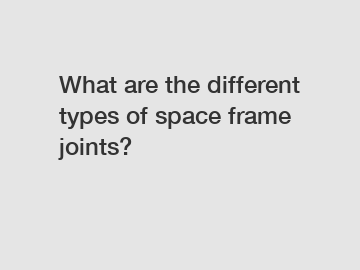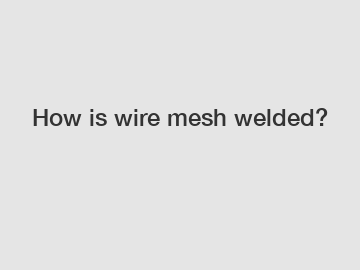What are the different types of space frame joints?
When it comes to constructing sturdy and visually captivating structures, space frames are often a top choice for architects and engineers. With their ability to efficiently distribute loads and maintain structural integrity, space frames have become an integral part of modern construction. However, these impressive structures wouldn't be possible without the crucial element of joints. In this article, we delve into the world of space frame joints, exploring their various types and their importance in creating stunning architectural wonders.
1. Rigid Joints.
Rigid joints form the backbone of space frame structures, delivering exceptional durability and stability. These joints, also known as fixed or fully restrained joints, allow for zero relative movement between members connected at the joint. Their design often consists of bolts, welding, or a combination of both, ensuring a seamless connection. Rigid joints effectively transfer loads between members, making them ideal for structures that require high resistance to bending and twisting forces.

2. Pinned Joints.
Pinned joints, as the name suggests, allow for rotation or movement at the connection point. These joints are frequently used in structures where flexibility is desired, allowing for the absorption of minor settlements or deformations. Pinned joints are usually achieved through the use of bolts, washers, or special connectors that permit rotation, minimizing stress concentration. Their ability to accommodate movement helps mitigate the effects of temperature variations and other external forces, making them appropriate for structures like retractable roofs or movable bridges.
3. Sliding Joints.
In some space frame applications, it may be necessary to allow for axial expansion and contraction between members due to temperature fluctuations or other factors. Sliding joints offer precisely that capability. These joints permit movement without impeding the overall stability of the structure. They are often designed with surfaces that enable sliding, such as Teflon or other low-friction materials. Sliding joints can be found in structures like long-span roofs or bridges, ensuring that the integrity of the structure is maintained under varying environmental conditions.
Additional resources:What is the difference between dome and skylight?
Graphite Electrodes: Unveiling How They Power Electric Vehicles & the Future of Clean Transportation
The Ultimate Guide to EN545 Ductile Iron Pipe
What are the advantages of ordering ASTM A53 seamless pipe from reliable suppliers?
What size mesh is an anti-climb fence?
Which Cutting Technique Can Maximize Efficiency for 4mm Special Blast Furnace Graphite Blocks?
7 Popular Wire Mesh Filter Products to Consider
4. Hinged Joints.
Hinged joints, also referred to as simply supported joints, provide a fixed connection for load transfer while allowing rotation in a specific direction. These joints are commonly utilized in applications where clearances are permissible, but bending moments need to be transferred. Hinged joints consist of pins that allow rotation in a single plane, facilitating the movement of the structure while avoiding excessive stress concentration. They are often prominent in structures such as tall buildings or pedestrian bridges, where controlled rotation is required to accommodate different load scenarios.
5. Articulated Joints.
Articulated joints provide the highest level of flexibility among all space frame joint types. These joints allow rotation in multiple directions, making them suitable for structures with complex geometry or those subject to dynamic forces. Articulated joints typically employ spherical bearings or universal joints, enabling a wide range of rotational movements. Their versatility allows structures to flex in response to varying loads and also enhances resistance against seismic events. Examples of structures incorporating articulated joints include grid shells and large domes.
Conclusion.
From timeless architectural marvels to awe-inspiring modern designs, space frame structures owe much of their resilience and aesthetic appeal to the joints that hold them together. Understanding the different types of space frame joints is vital for architects, engineers, and enthusiasts alike to appreciate the intricate balance of strength and flexibility they contribute to these structures.
Whether it is the rigidity of fixed joints, the freedom of movement provided by pinned joints, or the adaptability of sliding, hinged, and articulated joints, each type plays a unique role in achieving the desired structural outcome. By harnessing the possibilities offered by these various joint types, architects and engineers can continue to push the boundaries of innovation and create structures that inspire awe and admiration for generations to come.
For more Steel Space Frame Structure Warehouse, roof steel trusses, Space frame structures suppliersinformation, please contact us. We will provide professional answers.
Additional resources:Introduction to materials and advantages of stainless steel products
What kind of rubber do you use for a high temperature gasket?
Advantages and Applications of Aluminium Master Alloys
What are the uses of tungsten carbide rods?
Galvanized Steel Coil vs. Galvalume Steel Coil: Unveiling the Differences
What are the benefits of aluminum mesh?
Ultimate Guide to 1 Kg Graphite Crucibles: Best Prices, Comparison & Top Uses
Related Articles
-
What are the advantages of buying a color steel coil for sale compared to other options?
-
Unveiling the Allure of Brushed Gold Finish: Stylish, Durable & Perfect for a Luxurious Touch
-
Which is the best supplier for UNS N10276 in the purchase stage?
-
Discover Affordable Steel Rafters for Sale: Durable & Cost-Effective Solutions!









Comments
0